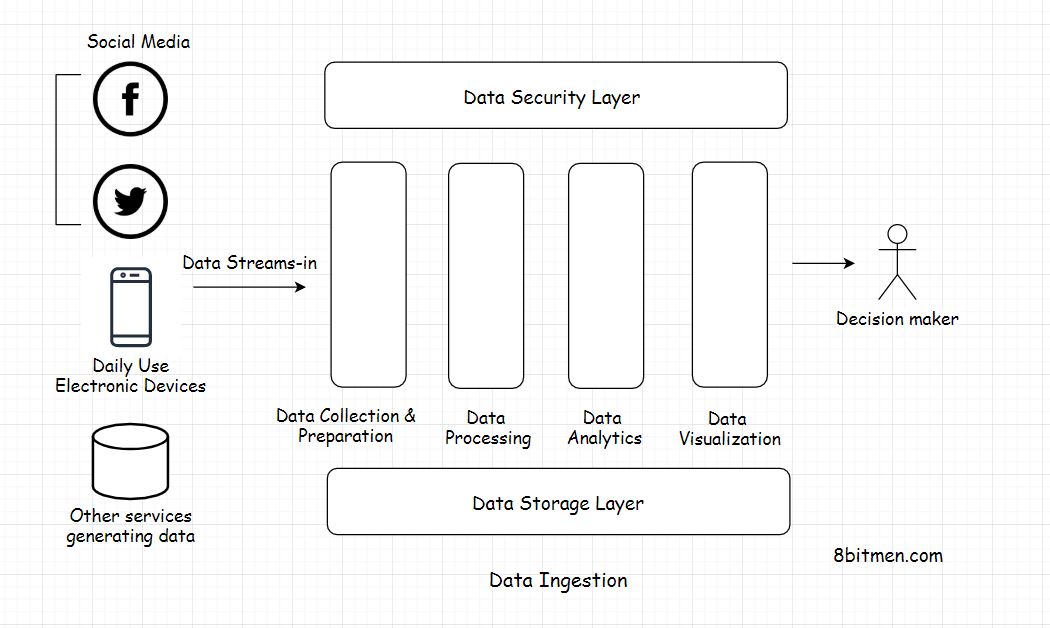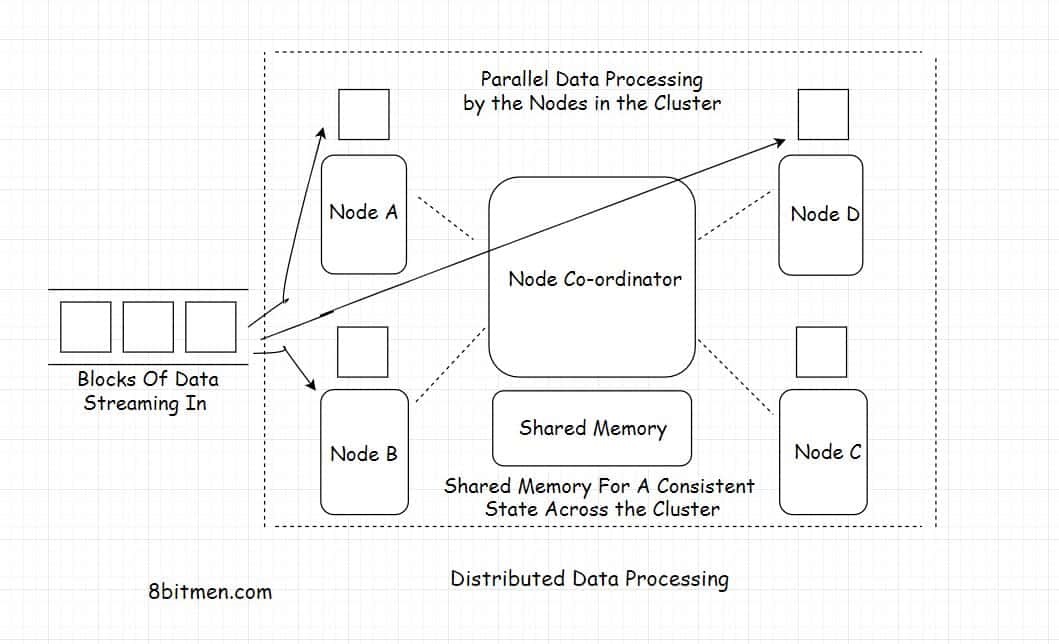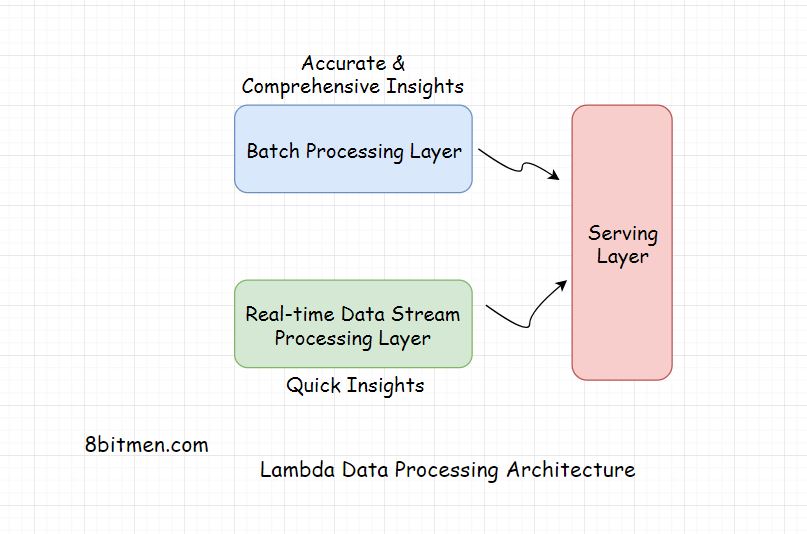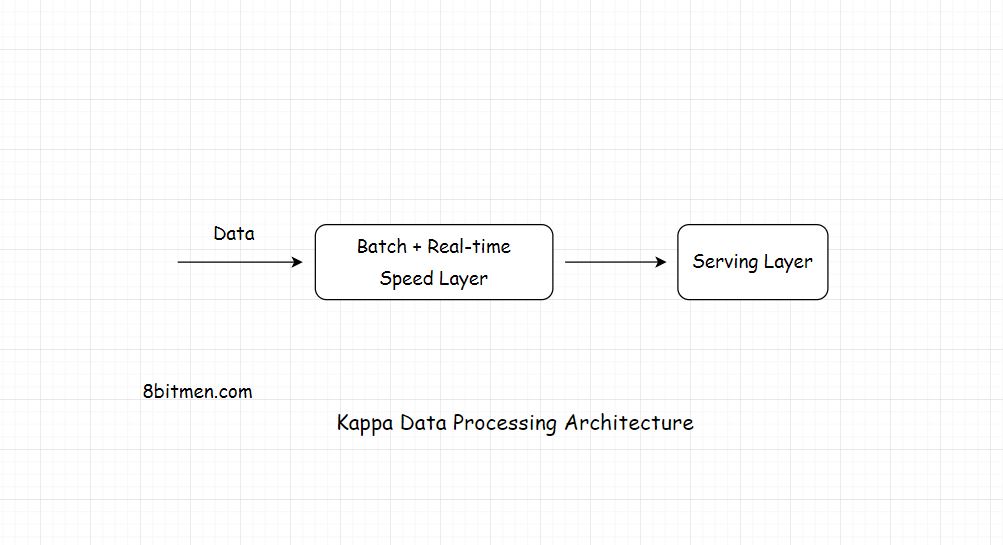Steam Processing
Data Ingestion
Data Ingestion is a collective term for the process of collecting data streaming-in from several different sources and making it ready to be processed by the system.
Layers of Data Processing Setup
(CPP+VSS)
- Data collection layer (Data standardization)
- Data preparation layer
- Data processing layer
- Data Analysis
- analytics models such as predictive modelling, statistical analytics, text analytics etc.
- Data visualization layer
- Kibana
- Data storage layer
- Data security layer

Ways of ingestion:
Real-time :
systems reading medical data like a heartbeat, blood pressure via wearable IoT sensors where the time is of critical importance;
financial data like stock market events etc.
Batches:
estimating the popularity of a sport in a region over a period of time.
Challenges
Conversion of data is tedious
analytics information obtained from real-time processing is not that accurate & holistic since the analytics continually runs on a limited set of data as it streams as opposed to the batch processing approach which takes into account the entire data set.
Lambda and the Kappa architectures of data processing
Gobblin is a data ingestion tool by LinkedIn.
At one point in time, LinkedIn had 15 data ingestion pipelines running which created several data management challenges.
To tackle this problem, LinkedIn wrote Gobblin in-house.
Gobblin Enters Apache Incubation | LinkedIn Engineering
Use cases
Moving Big Data Into Hadoop
Big Data from IoT devices, social apps, treams through data pipelines, moves into the most popular distributed data processing framework Hadoop for analysis & stuff.
15 IoT Big Data Examples You Should Know | Built In
Streaming Data from Databases to Elasticsearch Server
Java, String Boot & Elastic Search.
Log Processing
And logs are the only way to move back in time, track errors & study the behaviour of the system.
Ingest logs to a central server: ELK Elastic LogStash Kibana stack
Stream Processing Engines for Real-Time Events
Message queues like Kafka, Stream computation frameworks like Apache Storm, Apache Nifi, Apache Spark, Samza, Kinesis etc are used to implement the real-time large-scale data processing features in online applications.
Netflix’s real-time streaming platform
Data pipelines
Data pipeline facilitate the efficient flow of data from one point to another & also enable the developers to apply filters on the data streaming-in in real-time.
Features
- These ensure smooth flow of data.
- Enables the business to apply filters and business logic on streaming data.
- Avert any bottlenecks & redundancy in the data flow.
- Facilitate parallel processing of data.
- Avoid data being corrupted.
The entire flow of data extraction, transformation, combination, validation, converging of data from multiple streams into one etc. is completely automated.
Extract Transform Load.(ETL)
Extract means fetching data from single or multiple data sources.
Transform means transforming the extracted heterogeneous data into a standardized format based on the rules set by the business.
Load means moving the transformed data to a data warehouse or another data storage location for further processing of data.
ETL flow is done in batches, not real-time.
Apache Flink, Storm, Spark, Kafka
Migrating Batch ETL to Stream Processing: A Netflix Case Study with Kafka and Flink
Distributed Data Processing
Distributed data processing means diverging large amounts of data to several different nodes, running in a cluster, for parallel processing.
Apache Zookeeper is a pretty popular, de-facto, node co-ordinator used in the industry.

Since the nodes are distributed and the tasks are executed parallelly, this makes the entire set-up pretty scalable & highly available. The workload can be scaled both horizontally & vertically. Data is made redundant & replicated across the cluster to avoid any sort of data loss.
Distributed Data Processing Technologies
MapReduce – Apache Hadoop
MapReduce is a programming model written for managing distributed data processing across several different machines in a cluster, distributing tasks to several machines, running work in parallel, managing all the communication and data transfer within different parts of the system.
The Map part of the programming model involves sorting the data based on a parameter and the Reduce&
160;part involves summarizing the sorted data
The most popular open-source implementation of the MapReduce programming model is Apache Hadoop. The framework is used by all big guns in the industry to manage massive amounts of data in their system. It is used by Twitter for running analytics. It is used by Facebook for storing big data.
Apache Spark
Apache Spark is an open-source cluster computing framework. It provides high performance for both batch & real-time in-stream processing. It can work with diverse data sources & facilitates parallel execution of work in a cluster.
Spark has a cluster manager and distributed data storage. The cluster manager facilitates communication between different nodes running together in a cluster whereas the distributed storage facilitates storage of big data. Spark seamlessly integrates with distributed data stores like Cassandra, HDFS, MapReduce File System, Amazon S3 etc.
Apache Storm #
Apache Storm is a distributed stream processing framework. In the industry, it is primarily used for processing massive amounts of streaming data. It has several different use cases such as real-time analytics, machine learning, distributed remote procedure calls etc.
Apache Kafka #
Apache Kafka is an open-source distributed stream processing & messaging platform. It’s written using Java & Scala & was developed by LinkedIn.
The storage layer of Kafka involves a distributed scalable pub/sub message queue. It helps read & write streams of data like a messaging system.
Kafka is used in the industry to develop real-time features such as notification platforms, managing streams of massive amounts of data, monitoring website activity & metrics, messaging, log aggregation.
Hadoop is preferred for batch processing of data whereas Spark, Kafka & Storm are preferred for processing real-time streaming data.
Lambda Architecture

Batch processing does take time considering the massive amount of data businesses have today but with it the accuracy of the approach is high & the results are comprehensive.
real-time streaming data processing provides quick access to insights
Typically three layers
- Batch Layer - deals with the results acquired via batch processing the data
- Speed Layer - gets data from the real-time streaming data processing
- Serving layer - combines the results obtained from both the Batch & the Speed layers
Kappa Architecture

In Kappa architecture, all the data flows through a single data streaming pipeline as opposed to the Lambda architecture which has different data streaming layers that converge into one.
Two Layers
-
Speed - streaming processing layer
-
Serving
Kappa is preferred if the batch and the streaming analytics results are fairly identical in a system. Lambda is preferred if they are not.
Limitations
-
a distributed system does not promise Strong Consistency of data.
-
Not trivial to set up and manage a distributed data processing system, years of work.